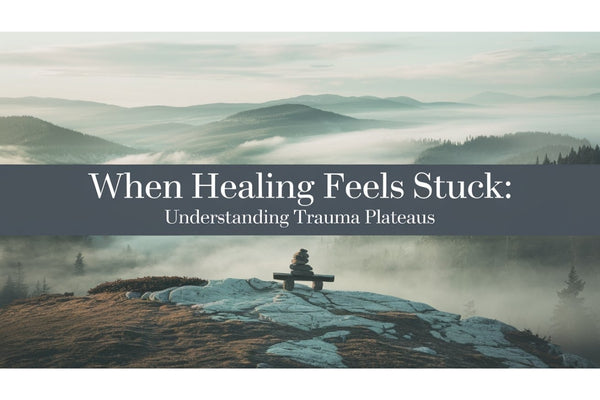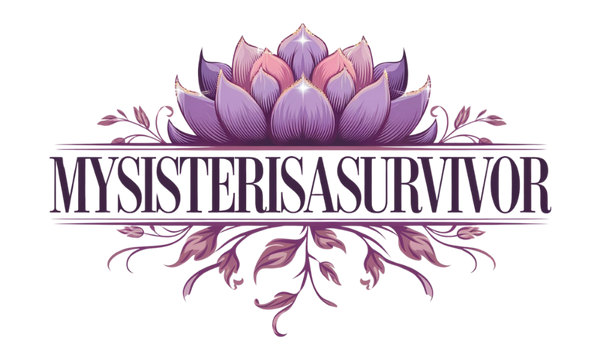
When Healing Feels Stuck: Understanding Trauma Plateaus
Share
Understanding Trauma Plateaus: Why Healing Isn’t Always Linear and How to Move Forward with Compassion
Healing from trauma is a journey unlike any other. It’s filled with moments of hope, progress, and sometimes, unexpected pauses that can feel frustrating or even discouraging. If you’ve ever felt like your healing has stalled or you’re stuck in a place where growth seems to have slowed - or stopped altogether - you’re not alone. This experience is known as a trauma plateau, and understanding it can be a powerful step toward continuing your healing with patience, self-compassion, and renewed hope.
What Is a Trauma Plateau?
Imagine hiking up a steep mountain trail. After climbing steadily for a while, you arrive at a scenic overlook where the path flattens. You stop, catch your breath, soak in the view, and prepare for the next climb ahead. In many ways, a trauma plateau is similar. It’s a natural pause or leveling off in your healing process, where progress may seem invisible or slow, but important internal work is happening.
A trauma plateau is a period when you might feel emotionally flat, numb, or stuck. You may experience frustration that your symptoms haven’t improved or feel less motivated to keep going. These moments can be confusing or disheartening, but they’re not signs that you’re failing or that your healing has ended. Rather, they are vital periods of rest, reflection, and reorganization for your mind and body.
Why Do Trauma Plateaus Happen?
Understanding why these plateaus occur helps us embrace them rather than fear them. Several factors contribute to these healing pauses:
1. Nervous System Regulation
Trauma deeply impacts the nervous system, often leaving it in a state of heightened alert or shutdown. Healing requires your nervous system to gradually regulate and find new balance. After intense periods of emotional work - like therapy sessions, journaling, or confronting painful memories - your body needs downtime to integrate and process these changes. This rest phase can feel like a plateau.
2. Surface of New Layers
Sometimes, as you peel back one layer of trauma, another surfaces. This unfolding can cause renewed symptoms or emotional discomfort, making it feel like you’ve regressed. This is a normal part of trauma recovery, reflecting deeper work being done beneath the surface.
3. Burnout from Constant Healing Efforts
Healing can be exhausting. If you’ve been pushing yourself hard without sufficient rest, your body and mind may trigger a plateau as a form of burnout protection. This signals the need to slow down and practice self-care.
Signs You Might Be Experiencing a Trauma Plateau
- Feeling emotionally numb or disconnected
- Frustration that symptoms like anxiety, flashbacks, or mood swings persist
- Decreased motivation to engage in healing activities
- Sense of hopelessness or feeling stuck in old patterns
- Physical fatigue or increased irritability
Recognizing these signs as part of a plateau rather than failure can shift your perspective and encourage self-kindness.
How to Move Forward Through a Trauma Plateau
The key to moving through a trauma plateau is to work with your mind and body - not against them. Here are some compassionate strategies to help you navigate this phase:
1. Rest Without Guilt
Give yourself permission to rest. Your brain is still processing trauma even when you’re not actively working on healing. Rest isn’t laziness; it’s essential recovery time. Prioritize sleep, gentle movement like stretching or walking, and calming activities like meditation or deep breathing.
2. Revisit Your Healing Tools
Sometimes returning to trusted tools can reignite your healing momentum. This could mean:
- Journaling about your feelings and progress
- Practicing grounding techniques to stay present
- Continuing therapy or support groups
- Using creative outlets like art or music to express yourself
Even small daily rituals can help maintain connection to your healing journey.
3. Shift Your Focus
When trauma feels overwhelming, try focusing on joy, creativity, and connection. Engage in activities that make you feel alive and present - whether it’s spending time with pets, gardening, cooking, or connecting with friends. These moments can provide balance and remind you that healing is multidimensional.
4. Seek Community Support
Isolation can deepen feelings of stuckness. Surround yourself with understanding people who validate your experience. Peer support groups, online communities, or trusted friends can offer encouragement, shared wisdom, and hope.
5. Practice Mindful Self-Compassion
Acknowledge your feelings without judgment. Speak to yourself as you would to a dear friend. Remind yourself that healing plateaus are not setbacks - they are part of the natural rhythm of growth.
Reframing the Trauma Plateau: Growth Incubators, Not Failures
It can be tempting to view plateaus as frustrating obstacles or evidence that healing “isn’t working.” Instead, try reframing them as growth incubators - quiet phases where your mind and body are integrating what you’ve learned and preparing for new breakthroughs.
Many survivors report that after a plateau, they experience sudden clarity, emotional breakthroughs, or increased resilience. This pattern of progress and pause is how deep transformation often unfolds.
The Journey Forward
Healing from trauma is neither quick nor straightforward, but it is possible - and you are not alone. Trauma plateaus may feel challenging, but they signal important internal work and strength. With patience, support, and self-compassion, you can move through these pauses and continue toward a life filled with hope, joy, and peace.
If you’re looking for ways to support your healing journey, check out our comforting blankets and journals designed to bring warmth, mindfulness, and gentle encouragement to every step you take.
